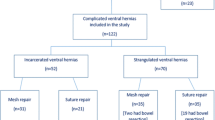Abstract
The management of large ventral hernias in patients undergoing elective colorectal surgery is controversial considering the reluctance to use a mesh during a clean-contaminated case. We retrospectively reviewed the charts of all patients having undergone at our institution any colorectal surgery along with ventral hernia repair with mesh as identified by the ICD-9 codes between 1997 and 2003. Three patients underwent incisional mesh herniorrhaphy along with elective colorectal surgery, including a right hemicolectomy, a colostomy closure, and a diverting colostomy. Hernia size varied between 330 and 1,243 cm2. All hernias were repaired using polypropylene mesh in an onlay fashion. Average operative time was 199 min. Two patients developed postoperative wound infection, one of them requiring incision and drainage of a part of the wound. One patient developed skin necrosis of the lower aspect of his incision requiring skin excision and open wound. All open wounds granulated well and healed by secondary intention despite presence of exposed mesh. Therefore prosthetic ventral hernia repair using polypropylene mesh can be performed concomitant to elective colorectal operations, thus avoiding another laparotomy. The incidence of wound complications is, however, high but does not usually require mesh excision.
Similar content being viewed by others
References
Leber G, Garb JL, Alexander AI, Reed WP (1998) Long-term complications associated with prosthetic repair of incisional hernias. Arch Surg 133:378–382
Birolini C, Utiyama EM, Rodrigues AJ Jr, Birolini D (2000) Elective colonic operation and prosthetic repair of incisional hernia: does contamination contraindicate abdominal wall prosthesis use? J Am Coll Surg 191:366–372
McLanahan D, King LT, Weems C, Novotney M, Gibson K (1997) Retrorectus prosthetic mesh repair of midline abdominal hernia. Am J Surg 173:445–449
Geisler D, Reilly JC, Vaughan SG, Glennon EJ, Kondylis PD (2003) Safety and outcome of use of nonabsorbable mesh for repair of fascial defects in the presence of open bowel. Dis Colon Rectum 46:1118–1123
Vix J, Meyer C, Rohr S, Bourtoul C (1997) The treatment of incisional and abdominal hernia with a prosthesis in potentially infected tissues: a series of 47 cases. Hernia 1:157–161
Byers JM, Steinberg JB, Postier RG (1992) Repair of parastomal hernias using polypropylene mesh. Arch Surg 127:1246–1247
Janes A, Cengiz Y, Israelsson LA (2004) Randomized clinical trial of the use of a prosthetic mesh to prevent parastomal hernia. Br J Surg 91:280–282
Steele SR, Lee P, Martin MJ, Mullenix PS, Sullivan ES (2003) Is parastomal hernia repair with polypropylene mesh safe? Am J Surg 185:436–440
Amid PK (1997) Classification of biomaterials and their related complications in abdominal wall hernia surgery. Hernia 1:15–21
Balen EM, Diez-Caballero A, Hernandez-Lizoain JL, Pardo F, Torramade JR, Regueira FM, Cienfuegos JA (1998) Repair of ventral hernias with expanded polytetrafluoroethylene patch. Br J Surg 85:1415–1418
Bleichrodt RP, Simmermacher RK, van der Lei B, Schakenraad JM (1993) Expanded polytetrafluoroethylene patch versus polypropylene mesh for the repair of contaminated defects of the abdominal wall. Surg Gynecol Obstet 176:18–24
Pennington DG, Lam T (1996) Gore-Tex patch repair of the anterior rectus sheath in free rectus abdominis muscle and myocutaneous flaps. Plast Reconstr Surg 97:1436–1440
Petersen S, Henke G, Freitag M, Faulhaber A, Ludwig K (2001) Deep prosthesis infection in incisional hernia repair: predictive factors and clinical outcome. Eur J Surg 167:453–457
Marchal F, Brunaud L, Sebbag H, Bresler L, Tortuyaux JM, Boissel P (1999) Treatment of incisional hernias by placement of the intraperitoneal prosthesis: a series of 128 patients. Hernia 3:141–147
Deysine M (1998) Pathophysiology, Prevention, and Management of Prosthetic Infections in Hernia Surgery. Surg Clin North Am 78:1105–1115
Franklin ME Jr, Gonzalez JJ Jr, Michaelson RP, Glass JL, Chock DA (2002) Preliminary experience with new bioactive prosthetic material for repair of hernias in infected fields. Hernia 6:171–174
Fernandez Lobato R, Martinez Santos C, Ortega Deballon P, Fradejas Lopez JM, Marin Lucas FJ, Moreno Azcoita M (2001) Colocutaneous fistula due to polypropylene mesh. Hernia 5:107–109
Losanoff JE, Richman BW, Jones JW (2002) Entero-colocutaneous fistula: a late consequence of polypropylene mesh abdominal wall repair: case report and review of the literature. Hernia 6:144–147
Usher FC, Ochsner J, Tuttle LL Jr (1958) Use of marlex mesh in the repair of incisional hernias. Am Surg 24:969–974
Vrijland WW, Jeekel J, Steyerberg EW, Den Hoed PT, Bonjer HJ (2000) Intraperitoneal polypropylene mesh repair of incisional hernia is not associated with entero-cutaneous fistula. Br J Surg 87:348–352
Acknowledgements
The authors acknowledge Timothy Flowers, MS, for his help in part of the data collection.
Author information
Authors and Affiliations
Corresponding author
Rights and permissions
About this article
Cite this article
Stringer, R.A., Salameh, J.R. Mesh herniorrhaphy during elective colorectal surgery. Hernia 9, 26–28 (2005). https://doi.org/10.1007/s10029-004-0274-x
Received:
Accepted:
Published:
Issue Date:
DOI: https://doi.org/10.1007/s10029-004-0274-x



